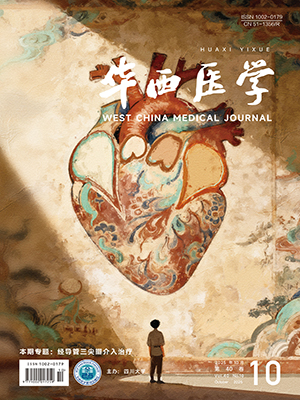| 1. |
Kubde D, Badge AK, Ugemuge S, et al. Importance of hospital infection control. Cureus, 2023, 15(12): e50931.
|
| 2. |
Lemiech-Mirowska E, Kiersnowska ZM, Michalkiewicz M, et al. Nosocomial infections as one of the most important problems of healthcare system. Ann Agric Environ Med, 2021, 28(3): 361-366.
|
| 3. |
Zong Z, Wu A, Hu B. Infection control in the era of antimicrobial resistance in China: progress, challenges, and opportunities. Clin Infect Dis, 2020, 71(Suppl 4): S372-S378.
|
| 4. |
Russo A, Fusco P, Morrone HL, et al. New advances in management and treatment of multidrug-resistant Klebsiella pneumonia. Expert Rev Anti Infect Ther, 2023, 21(1): 41-55.
|
| 5. |
Chala B, Hamde F. Emerging and re-emerging vector-borne infectious diseases and the challenges for control: a review. Front Public Health, 2021, 9: 715759.
|
| 6. |
杨亚红, 张浩军, 朱腾飞, 等. 甘肃省 44 家医疗机构医院感染管理工作现状调查. 中国护理管理, 2022, 22(2): 281-285.
|
| 7. |
杨璐, 余旭霞, 朱越献, 等. 浙江省 68 所中医医疗机构感控专职人员现状调查. 中医药管理杂志, 2024, 32(6): 28-32.
|
| 8. |
国务院应对新型冠状病毒肺炎疫情联防联控机制综合组. 关于进一步做好常态化疫情防控下医疗机构感染防控工作的通知. 中华人民共和国国家卫生健康委员会公报, 2020(12): 271-273.
|
| 9. |
国务院应对新型冠状病毒肺炎疫情联防联控机制综合组. 关于进一步加强医疗机构感控人员配备管理相关工作的通知. 中华人民共和国国家卫生健康委员会公报, 2021(8): 10-11.
|
| 10. |
史庆丰, 胡必杰, 高晓东, 等. 我国医院感染管理人员岗位胜任力研究综述. 上海预防医学, 2024, 36(5): 511-515.
|
| 11. |
石磊, 高晓东, 胡必杰, 等. 上海市医院感染专职人员职称晋升现状调查. 中华医院感染学杂志, 2022, 32(8): 1253-1256.
|
| 12. |
Dhar S, Sandhu AL, Valyko A, et al. Strategies for effective infection prevention programs: structures, processes, and funding. Infect Dis Clin North Am, 2021, 35(3): 531-551.
|
| 13. |
曾欣, 张慧, 李春燕, 等. 后疫情时代高校医院感染管理人才培养初探. 现代预防医学, 2022, 49(24): 4533-4536.
|
| 14. |
乔甫, 宗志勇. 疫情时代的医院感染预防与控制: 机遇与挑战. 华西医学, 2022, 37(3): 321-325.
|
| 15. |
程棣妍, 乔甫. 世界卫生组织《感染预防与控制专业人员核心能力》实践路径. 华西医学, 2023, 38(3): 326-337.
|
| 16. |
Choi J. Development of a competency for infection control nurses in Korea. Am J Infect Control, 2020, 48(Suppl 8): S36.
|
| 17. |
张发滨, 谢意兰, 韩晓东. 广东省 833 家二级以上医疗机构感染防控专职人员队伍建设情况及对策. 现代医院, 2023, 23(11): 1753-1756.
|
| 18. |
陈相龙. 感控管理待加磅. 中国医院院长, 2020(15): 45-46.
|
| 19. |
孙慧, 姜亦虹, 周珏. 江苏省 102 所中医医院感染管理资源配置现状调查. 吉林医学, 2020, 41(2): 505-508, 511.
|
| 20. |
张志刚, 魏秋霞, 杨致霈, 等. 陕西省中医医疗机构医院感染管理专职人员工作倦怠现状分析. 职业与健康, 2020, 36(13): 1729-1731, 1735.
|
| 21. |
刘波, 张永祥, 陈文森, 等. 江苏医院感染领域医师职称晋升的探索与尝试. 中华医院感染学杂志, 2017, 27(14): 3143-3146.
|
| 22. |
张孟媛, 张瑶, 粟小燕, 等. 2020 年四川省市级疾控机构卫生应急管理人员业务能力调查. 职业卫生与病伤, 2023, 38(4): 255-260.
|
| 23. |
陈旭东, 段静琰. 对深化云南省医疗卫生事业单位专业技术岗位设置与管理改革的思考. 中国人事科学, 2022(3): 11-24.
|
| 24. |
Chen N, Li S, Kuang Z, et al. Identifying a competency improvement strategy for infection prevention and control professionals: a rapid systematic review and cluster analysis. Health Care Sci, 2024, 3(1): 53-66.
|
| 25. |
杨亚, 班海群, 高晓东, 等. 2021 年上海市医院感染管理科主任岗位胜任力现状及其影响因素. 中华医院感染学杂志, 2023, 33(18): 2870-2874.
|
| 26. |
Zhang P, Tang L. Current status of infection control professionals in a Chinese city. Infect Control Hosp Epidemiol, 2019, 40(8): 949-950.
|
| 27. |
Clifford RJ, Newhart D, Laguio-Vila MR, et al. Infection preventionist staffing levels and rates of 10 types of healthcare-associated infections: a 9-year ambidirectional observation. Infect Control Hosp Epidemiol, 2022, 43(11): 1641-1646.
|




